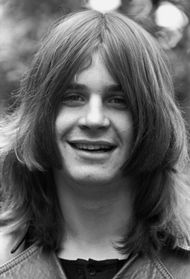Ozzy Osbourne has been considered one of the pillars of heavy metal music. Together with his band Black Sabbath, he was among the first musicians to explore dark vocals and spooky sounds and to unleash a new era of unapologetic boldness. The thing that made the difference between Ozzy Osbourne and other singers was his captivating performance on the stage, as well as his dangerous and, at the same time, fragile vocals.
Over the decades, he transformed from a 'prince of darkness' to an amalgam of emotion, theatricality, and a larger-than-life figure. He has further evolved this image through anthems that are wildly touching or deeply powerful during his solo work.
Ozzy Osbourne never tried to play it safe, and his music has always shown a reflection of his struggle to keep alive in a world that many times doesn't make sense, which is something not many people can pull off, and that’s why his music stood out. Ozzy Osbourne didn't just follow trends, but actually inspired lots of artists who have followed through.
Ozzy Osbourne's legacy is being stretched across cultures and decades, and it proves that Ozzy Osbourne isn't just part of metal; he is metal. Metal isn't the answer; it’s often seen by many as the voice for people who feel lost, and that isn’t something everyone can do. Behind all that crazy performance stuff, there's a career that has lasted a long time and built the basics for a whole genre. But beneath all that theatrical darkness lies a career that's not just long-lasting, but foundational.
When he was pushed out of Black Sabbath, few could've predicted he'd rise even higher on his own. With Randy Rhoads joining him, the first solo records by Ozzy Osbourne didn't just turn out alright, they made a difference.
And they followed the way those albums showed; they didn't just get lost in the shadow that Sabbath left behind, and the path was lit by them. It must be hard to catch that same spark, but praise was still given to his work, and people did not stop listening; they kept changing.
The sound and look that Ozzy Osbourne created did more than just stand in heavy metal; he shaped it and moved it to new places, and he contributed to art and design. Music history has Ozzy Osbourne's name basically carved right into it, so his effect is more than just stories people tell.
Disclaimer: This article contains the writer's opinion. The reader's discretion is advised!
Here are the top 8 Ozzy Osbourne songs of all time
These are the eight leading Ozzy Osbourne songs of all time. They are not merely fan favorites; they capture the essence of his legacy as an artist. His voice is the centerpiece of Crazy Train and Mr. Crowley, and with both songs, we can appreciate all the different sides of Ozzy Osbourne.
It is dark and gloomy, yet theatrical and deeply melodic at the same time. While Bark at the Moon displays his ability to seamlessly tell horror-themed stories while delivering hard rock punch, No More Tears proves his emotional approach to music, and sprawling way of composing, matched his dramatic public persona.
Tracks like Diary of a Madman and Flying High Again underline his creative chemistry with guitarist Randy Rhoads, while Mama, I'm Coming Home reminds us that even the Prince of Darkness can deliver a power ballad with soul. These eight songs aren't just highlights, they're milestones in metal history.
1) Mama, I'm Coming Home (1991)
Mama, I'm Coming Home came out in 1991, and it showed a different side of Ozzy Osbourne, the side that was emotional, vulnerable, and very human. Ozzy Osbourne was known for his heavy and often menacing sound, and he shattered that image with this power ballad, where he replaced the foreboding riffs with the acoustic comfort and emotional helplessness in his lyrics.
The song, co-written with Motörhead's Lemmy Kilmister, is not only musically different on the No More Tears album, but emotionally as well. The song itself is, at its most fundamental level, a letter, a confession set to music; addressed to Sharon Osbourne, though it reaches out to everyone who has ever needed the comfort of an arm around the shoulder, the balm of healing, or a place to call home.

Ozzy Osbourne has a pain in his voice that pierces through the production, and the song deals with regret, reconciliation, and the emotional price of a life spent on the road. The guitar solo performed by Zakk Wylde does not attempt to overpower the song; rather, it goes with the emotion, reprising the subdued power of the song with a reserved yet melodic poise. The song was not dependent on spectacle and shock value like many of his other hits.
It took strength in sincerity. Mama, I'm Coming Home was one of the most successful singles of Ozzy Osbourne, not because he tried to scream over the past, but because he lowered his voice and allowed earnestness to do the talking. It is a song that has never lost its relevance, not only to rock enthusiasts but to any person who has ever felt the burden of miles and the irrepressible call of home.
Read More: 6 greatest Stevie Wonder songs that defined his legacy
2) Shot in the Dark (1986)
A fairly refined song in the Ozzy Osbourne discography, Shot in the Dark established its own niche upon its release in 1986 as a feature of The Ultimate Sin. A bit of a departure (at the time) out of his heavier roots, the song still sported the slick production of the mid-80s without foregoing Ozzy-esque dark topics.

Immediately in the first notes, it has a melodic smoothness that draws you in, the synths glimmering and the guitar licks sharp, as the sound is clean, yet never cold. The guitar, provided by Jake E. Lee, is clear and shiny, witty and teeth-gritting, particularly in the solo, which is neither too flashy nor too emotionless. The chorus is pure stadium-rock splendor, made to bounce off the walls of arenas and remain lodged in your brain long after.
Behind all the glamour, the lyrics point to a more complex conflict at work: temptation, rebellion, and the nervous excitement of doing something you know is wrong. The making of the album was not devoid of behind-the-scenes drama, but Shot in the Dark somehow transcended all that, becoming a huge radio and MTV hit. It was more than a catchy tune; it was a time when glam came face to face with grit, and Ozzy Osbourne stepped across the line with uncanny swagger.
3) Dreamer (2001)
Dreamer, a song by Ozzy Osbourne's 2001 album, Down to Earth, removes the layers of his constructed public persona and exposes something more personal and unexpectedly sweet. Ozzy Osbourne is known more for his raucous stage antics and his darker material, so it comes as quite a surprise here as he presents a song that is actually more of a hopeful nature than a horrific one.
With the subtle piano tune and lush orchestra accents, the song has more of a movie appeal of a plea rather than a rock ballad. His voice, which would more commonly be identified with snarling energy or spooky theatrics, is instead delivered soft but certain, as though he were not merely singing, but somewhat urgently whispering to a more humane world.
The lyrics are not preachy or lecturing; they are more like soft questions and desires of humanity that show a different side of Ozzy Osbourne that is many times obscured by the larger-than-life image that he projects. A co-write with Tim Palmer and Marti Frederiksen, Dreamer addresses the sort of emotional nakedness that requires no genre allegiance, finding an audience that might never have related to his more aggressive work.
It appealed to all ages and musical preferences, a testament to the fact that authenticity tends to run deeper than flashiness. The song is, on its most basic level, about the courage to cling to hope in a world that is growing ever more uncertain, and in that respect, it proved to be one of the most subtly powerful moments in a long and unpredictable career of Ozzy Osbourne.
4) Over the Mountain (1981)
The perfect opener to Diary of a Madman, Over the Mountain does not hold back, throwing the listeners directly into the hurricane of sound and stress. The drumming of Tommy Aldridge comes smashing in first like a warning, then very closely the blistering guitar riff of Randy Rhoads, which seems more of an invocation than an intro.
The song has a momentum that does not release, a forward drive that reflects the words, Ozzy Osbourne singing not merely about fabulous trips, but seeking something more fundamental, more personal, almost celestial. The words are about a sort of spiritual impatience, a desire to burst the bonds of the flesh and the feeling.
Ozzy Osbourne sings high over the top of the lush arrangement, not merely shouting out lines but enhancing them with a weird combination of rage and vulnerability.

He feels like a man seeking answers in the pandemonium. What really makes the song, however, is how it helps to capture the silent conversations between Ozzy Osbourne and Rhoads as they each urge the other on to be more, play louder, dig deeper. The solo Rhoads plays after that is a masterclass in speed and emotion, blistering and yet considered, not simply technique but a tale unto itself.
This is the combination of emotional heaviness, uncompromising speed, and musical elegance that makes Over the Mountain not merely a good opener but a very good song. It serves as a mission statement to the solo adventure of Ozzy Osbourne: wild, personal, and not at all afraid of running the knife along the boundary between the flesh and the supernatural.
5) Crazy Train (1980)
Now, when Ozzy Osbourne walked out on his own in 1980 with Blizzard of Ozz, Crazy Train was not simply a first single; it was a statement of intent. Starting with the very first seconds, the shrieking guitar riff by Randy Rhoads cuts through the silence with the urgency that cannot be overlooked.
What comes next is a high-voltage cocktail of mayhem and lucidity, powered by the instantly recognizable voice of Ozzy Osbourne and the virtuosic fretwork of Rhoads.
It takes the anxiety of its era: Cold War paranoia, nuclear panic, and general disillusionment, and rather than crumbling under the pressure, it pitches forward in rebellion and vitality. Ozzy Osbourne is not simply screaming into the abyss; he is calling his audience to arms to think, to feel, to doubt.

Those are the combination of the unrest and the melody that make the song Crazy Train so powerful; it is not a shallow or mindless song, it is not a violent song that lost touch with humanity.
The chorus is enormous, anthemic, and it seems created to fill arenas even before it resounded there. Then there is the solo of Rhoads, the combination of classical accuracy and pure rock instinct that makes the song not just great, but legendary. The production by Max Norman has that elusive quality: slick but also rough and loud, it could easily reach the radio charts and the underground clubs.

More than 40 years after its release, Crazy Train has not aged; it continues to be played in stadiums, sampled in popular culture, and adored by metalheads and casual listeners alike. It is not just a fan favorite, but it is also a rite of passage.
It is the first time that many people felt what heavy metal can be. Riotous, electric, and unquestionably alive, Crazy Train not only launched Ozzy Osbourne into his solo career but also became implanted in the very DNA of rock.
6) No More Tears (1991)
It was in 1991 when Ozzy Osbourne released a turning point in his career, the song titled No More Tears, which saw the music of this performer acquire a more global and textured sound. It is not another hard rock song; it is nearly seven minutes long, and it seems more like an expedition to the gloomy recesses of the human soul.
The pace of the song is established by the slow, reverberating bassline as it introduces the song, quickly joined by the screeching guitar of Zakk Wylde, which pierces through the mix with its intensity. Forgetting about shock value and theatrics, Ozzy Osbourne here embraces pure emotion, delving into the themes of emotional conflict and personal hell with unexpected openness.
His weathered yet strong voice provides a nice texture to lyrics that are more personal than theatrical. The erratic form of the song, tempered with variable speeds, lengthy improvisations, and vocal variations, seems less like a pop song on the radio and more like a rock concept album.
On No More Tears, Ozzy Osbourne not only did not leave the metal formula alone, but he reinvented it and demonstrated that he could still break his own limits and excite both old and new generations of fans.
7) Mr. Crowley (1980)
The song of Ozzy Osbourne's 1980 solo debut, Blizzard of Ozz, Mr. Crowley was not simply another heavy metal song, but a spooky excursion into the occult, cloaked in mood and theatrics. Based on the life of Aleister Crowley, who became infamous due to his associations with the occult, the song does not merely name-drop, but it analyzes.
A ghostly organ intro by Don Airey on the very first notes sets a gothic mood that is more possessed stage than a rock concert. Ozzy Osbourne's vocals come along like a question in a dark cathedral- curious, unnerved, and theatrical. Then comes Randy Rhoads with a flying, classically influenced guitar solo that not only impresses but lifts the entire thing to a level that borders the opera.
It was not metal as a means to an end (noise), but rather a continuation of the tradition of storytelling, with shadow and spectacle. Mr. Crowley created the gap in which metal could be mindbending and spine-chilling, and he mined a vibe that numerous groups would subsequently pursue.
Gothic and edged with drama, the song never went out of date; on the contrary, it became the foundation of the more mystical approach in the genre, establishing its reputation as one of the most haunting songs that Ozzy Osbourne ever made.
8) Flying High Again (1981)
Not only does Fly High Again, off the 1981 Diary of a Madman, by Ozzy Osbourne rock, but it takes off. The song provides a headrush of sound in which the guitar work of Randy Rhoads flirts with being playful and electrifying, and flashy fretwork is piled on top of a beat that keeps the momentum going. Ozzy Osbourne is throwing his voice into the song with a smile, pouring out a sort of roguish spontaneity.

It is a song that can be interpreted a hundred different ways, a wink at drugs, a finger to the man, or perhaps simply a huzzah to following your own path, and that ambiguity only makes it more compelling. None of that deep gloom, it is a band at its prime, style tossed to the wind, and playing like they are enjoying every moment.
It is sloppy, rowdy, and energetic, a song that continues to resonate even though it does not overreach to insist that it means something. It simply exists, and that is what makes it fly.
Ozzy Osbourne's work captures the essence of heavy metal from its birth through several decades, featuring remarkable riffs and theatrical showmanship. His distinctive voice defined the genre alongside his Black Sabbath roots, and his later solo career, characterized by tumultuous creativity and marvelous disorder, reflects unwavering defiance and even more mighty transformation.
Keep reading SoapCentral for more informative content!
Also Read: 7 iconic Ramones songs every American rock fan knows
